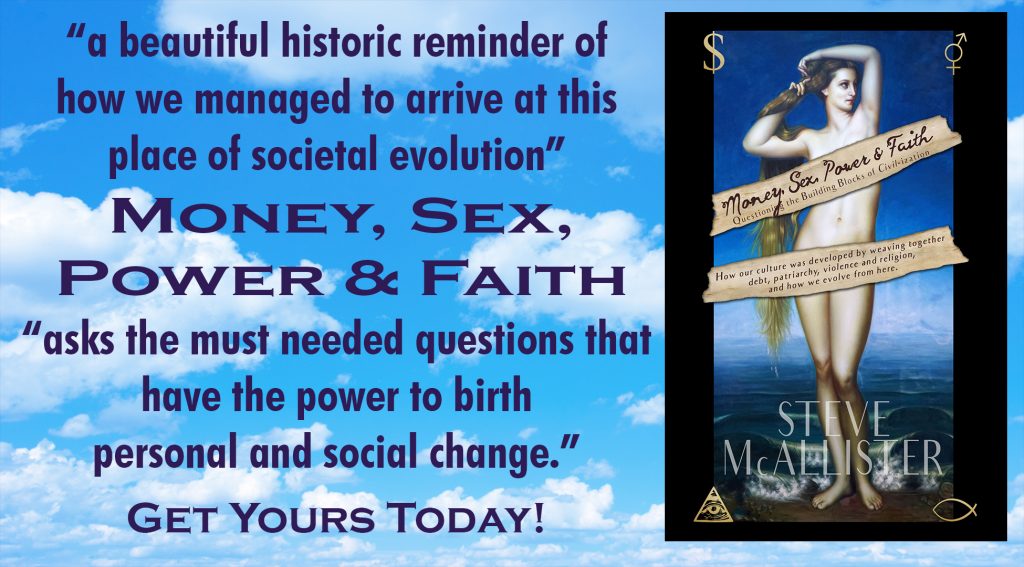The following is a chapter from Money, Sex, Power & Faith.
Order your copy in paperback or for Kindle!
“The owners of this country know the truth… it’s called the American dream because you have to be asleep to believe it!” – George Carlin

In 1931, historian James Truslow Adams popularized the phrase “American Dream”. In Epic of America, he writes, “that dream of a land in which life should be better and richer and fuller for every man, with opportunity for each according to his ability or achievement. It is a difficult dream for the European upper classes to interpret adequately, and too many of us ourselves have grown weary and mistrustful of it. It is not a dream of motor cars and high wages merely, but a dream of social order in which each man and each woman shall be able to attain to the fullest stature of which they are innately capable, and be recognized by others for what they are, regardless of the fortuitous circumstances of birth or position.”5
That dream seems to have come to its fullest fruition in the mid-20th century, and has been getting hazier ever since. According to the study “Economics and Happiness : Framing the Analysis” by Luigino Bruni and Pier Luigi Porta, America seems to have hit its peak happiness levels in 1956. Unfortunately, as happy as we think all of our technologies, industriousness, and ostentatiousness make us, and even though our average income has skyrocketed, Americans only reached a peak of about forty on the “very happy” scale.5 It may seem hard to believe with each of us having our own cars, domiciles, TVs, and personal gizmos with which we whittle away our time and attention, but there is much room for us to be happier.
They were good times in 1956. Thanks to a higher rate of economic equality, almost everyone had spending power, making social mobility possible. And thanks to the GI Bill, some 7.8 million veterans had been able to come home from war and learn to do something else with their lives, helping them to deal with the horrors they had experienced through education and productivity. With suburbia on the brink of popularity, the American Dream was seemingly available for everyone, with just a little hard work and optimism. Crime was down, and as quarter acre kingdoms sprouted up across the land, the middle class had some nobility to reach for as they claimed their own segments of real estate.
Adams went on to expand upon The American Dream, stating that it “has not been a dream of merely material plenty,” but that it “has been a dream of being able to grow to fullest development as man and woman, unhampered by the barriers which had slowly been erected in the older civilizations, unrepressed by social orders which had developed for the benefit of classes rather than for the simple human being of any and every class.”
Unfortunately, though America extolled the virtues of life, liberty, and the pursuit of happiness, it was still built on older civilizations. Though the classes weren’t as pronounced as they had been in other times and places, they were still there, and the seams of repression were still showing. While America seemed to have it as good as it could possibly get, many Americans grew dissatisfied with the good life that had been manufactured to keep industry thriving and the economy growing, and within the decade, our happiness began to decline.
As the youth of the Sixties watched their mothers join their fathers in the workplace, they began to become disillusioned with the premise of the forty-hour workweek, suburban landscapes, and the support of the military industrial complex of which Eisenhower had warned. They grew wary of the “rat race” and the sense of community which had been lost amid the racism, sexism, greed, and classism the prevailing government and religion had wrought. As they sought the peace and love of which Jesus had spoke, they explored Eastern religions and taboo hallucinogens for the eternal life beyond the dogmas and structures of the dominant culture, heading off to find themselves and leaving familial traditions behind.
As the Hippies and Yippies made off to break free from the societal norms of patriarchy and industrialism, the rest of society was also experiencing shifts in the ideas of monogamy and sexuality. The sexual revolution broke the bonds of the nuclear family and expanded sexuality beyond the confines of marriage, ushering in movements of more openness in homosexuality, spouse-swapping, pornography, and feminism. With pharmacology now offering women the opportunity to control their own reproduction through birth control pills, women found much greater freedom to control their own sexual destinies, a heretofore unknown premise in the predominant culture of patriarchy.
“Each and every time an unmarried woman had intercourse,” as Nancy L. Cohen writes in Delirium: How the Sexual Counterrevolution is Polarizing America, “she risked pregnancy, and with it a limited number of unsavory life-changing options: an illegal abortion of doubtful safety, a shotgun wedding, forced adoption, or single motherhood of a child whose birth certificate would be stamped for posterity with the word ‘illegitimate’. With rare exceptions, all known human cultures have policed the sexual behavior of girls and women, and America, circa 1959, was no different. Before women obtained the power to control their fertility, they had compelling reasons to comply with whatever arbitrary double standard their society imposed. The Pill permanently changed women’s age-old pragmatic calculus. With a little pharmaceutical ingenuity, the double standard relaxed its clawing grip on female humanity.”5
“Before the revolution,” Cohen goes on, “the whims of men determined the reputation, if not the fate, of women; female desire was contained within the closet of marriage; and men retained their traditional sexual privileges and discreetly enjoyed their sexual liberties. After the revolution, women, if they so chose, could dispense with men, or with marriage altogether, without giving up sex or children or a lifetime loving relationship. Of course, most women continued to love men, marry men, and have children with men. The point, however, was that for the first time in human history, women had a choice.”
However, while women were embracing new roles of participation in the workplace, in the voting booth, and in the bedroom, the male-dominated publishing industry started to convey women in a much less revolutionary light, as pin up girls and eye candy.
“The sexual revolutionaries of the 1960s,” Naomi Wolf states in Vagina: A New Biography, “including advocates for ‘adult’ material such as Hugh Hefner and Al Goldstein, represented porn to us as a great social radicalizer. But a nation of masturbating people who are looking at screens rather than at one another – who are consuming sex like any other product and who are rewiring their brains to find less and less abandon and joy in one another’s arms, and to bond more and more with pixels – is a subjugated, not a liberated, population.”5
As pornography has blossomed into a multi-billion dollar a year industry since Playboy first hit the newsstands in 1953, rivaling the bottled water industry in 2012, the new rite of passage for young men learning about female sexuality through air-brushed poses and emotionally detached fantasies has created an indelible rift in our understanding and appreciation for sacred sexuality. “For the first time in history,” Naomi Wolf wrote in The Beauty Myth, “children are growing up whose earliest sexual imprinting derives not from a living human being, or fantasies of their own; since the 1960s pornographic upsurge, the sexuality of children has begun to be shaped in response to cues that are no longer human… Today’s children and young men and women have sexual identities that spiral around paper and celluloid phantoms: from Playboy to music videos to the blank females torsos in women’s magazines, features obscured and eyes extinguished, they are being imprinted with a sexuality that is mass-produced, deliberately dehumanizing and inhuman.”5
The embracing of pornography by men who were trying to understand the feminine amid this change of protocol, fanned the flames of disenfranchisement and exacerbated the separation for which suburbanism had laid the groundwork. While the sexual revolution helped pave new roads for women, homosexuals, and others who were seeking more freedom of sexual expression and more equality between the sexes, it also helped incite the breakdown of the familial unit, which had come to be the cornerstone of American life.
“Like the waning of Christianity,” writes Mary Eberstadt in How the West Really Lost God: A New Theory of Secularization, “the waning of the traditional family means that all of us in the modern West lead lives our ancestors could not have imagined. We are less fettered than they in innumerable ways; we are perhaps the freest people in the history of all humanity. At the same time, we are also more deprived of the consolations of tight bonds of family and faith known to most of the men and women coming before us—and this fact, it will be argued, has had wider repercussions than have yet been understood.”5
After the high point of happiness and the purported fulfillment of the American Dream, the backlash of its climax was the decline of enthusiasm for all that it apparently offered. The breakdown of the nuclear family unit also contributed to the dissolution of the Judeo/Christian tradition that had spawned it. Although a band of Hippies did manage to splinter off into the movement of the “Jesus People” in the early 1970s when only 5% of adults reported no religious affiliation, according to the General Social Survey of the University of Chicago’s National Opinion Research Center, by 1990, it was 8% and by 2014, that number grew to 21%.5
Without these last remaining vestiges of interdependence in a culture which had given way to consumerism, the continued decline set the stage for the complete actualization of the purported selfishness which would
make capitalism fully thrive.
Order your copy of Money, Sex, Power & Faith today!


